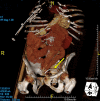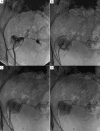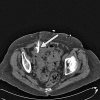Percutaneous retrieval of a biliary stent after migration and ileal perforation
- PMID: 19183489
- PMCID: PMC2642780
- DOI: 10.1186/1749-7922-4-6
Percutaneous retrieval of a biliary stent after migration and ileal perforation
Abstract
We present a case of a migrated biliary stent that resulted in a distal small bowel perforation, abscess formation and high grade partial small bowel obstruction in a medically stable patient without signs of sepsis or diffuse peritonitis. We performed a percutaneous drainage of the abscess followed by percutaneous retrieval of the stent. The entero-peritoneal fistula closed spontaneously with a drain in place. We conclude, migrated biliary stents associated with perforation distal to the Ligament of Trietz (LOT), may be treated by percutaneous drainage of the abscess and retrieval of the stent from the peritoneal cavity, even when associated with a large intra-abdominal abscess.
Figures




References
-
- Lammer J, Neumayer K. Biliary drainage endoprostheses: experience with 201 placements. Radiology. 1986;159:625–629. - PubMed
-
- Mueller PR, Ferrucci JT, Jr, Teplick SK, vanSonnenberg E, Haskin PH, Butch RJ, Papanicolaou N. Biliary stent endoprosthesis: analysis of complications in 113 patients. Radiology. 1985;156:637–639. - PubMed
LinkOut - more resources
Full Text Sources

